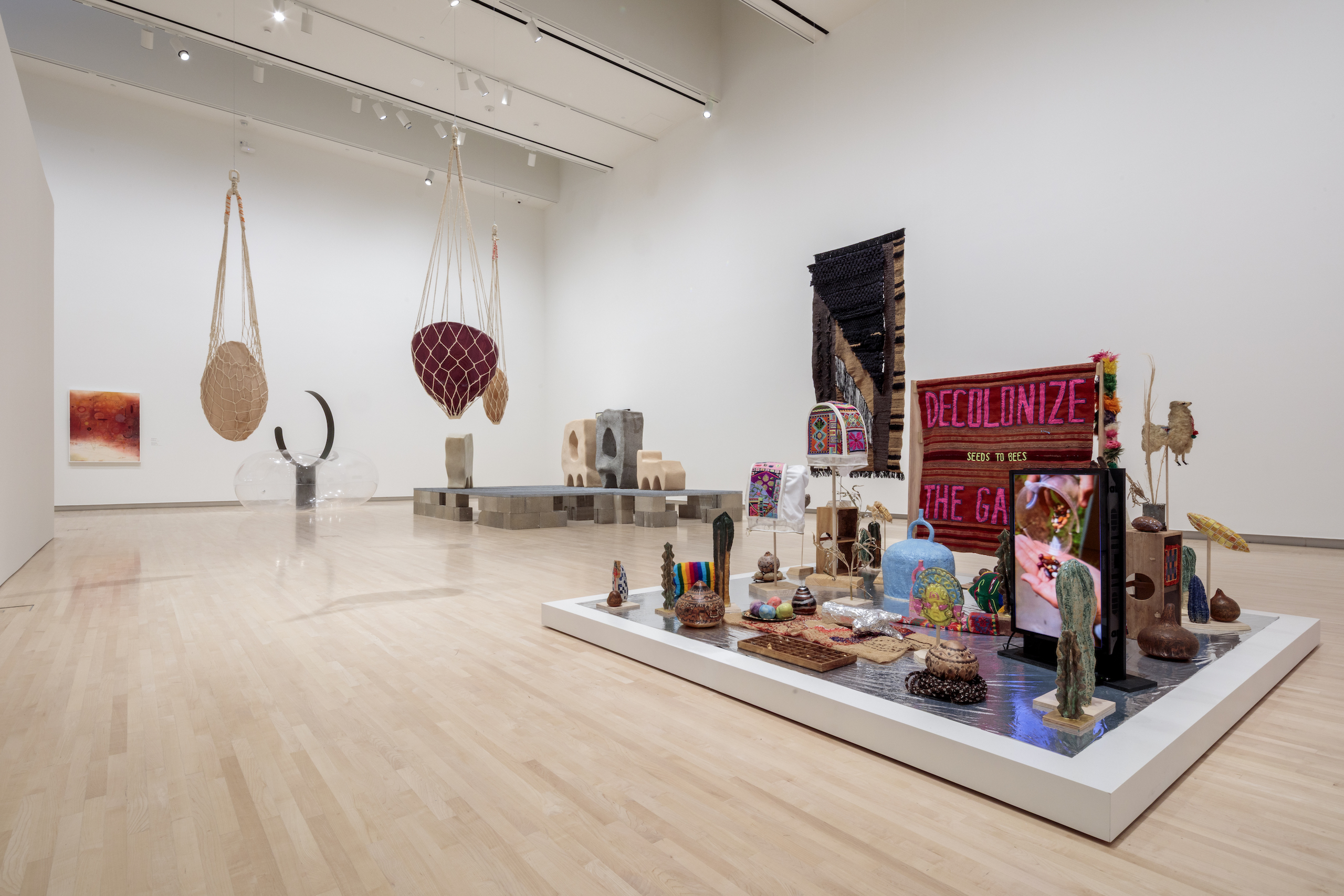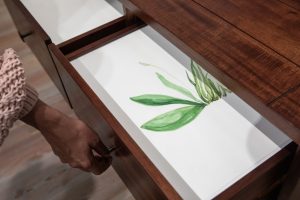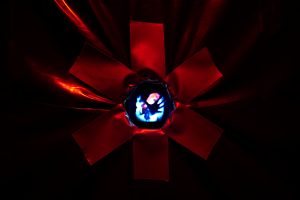Octavia Butler’s speculative dystopian novel, Parable of the Sower, begins with the tenet, “All that you touch, you change. All that you change, changes you. The only lasting truth is change.” Written in 1993 and set in 2024-2027 during a critical time of volatility in the U.S. due to climate change, social injustice, and wealth inequality, Parable of the Sower follows a young woman, Lauren Olamina, who conceives the religion Earthseed as a means to seek possibilities beyond Earth. When life becomes increasingly untenable, Earthseed builds from historical texts to live sufficiently from the land and foster community, striving to “take root among the stars.” Adapting to the unknown is imperative not only for survival but for the potential to flourish.
As our present reality unfolds like Butler’s novel, with private and corporate interests willfully exhausting the Earth’s resources and eroding fundamental rights, the exhibition, Seeds: Containers of a World to Come, provides a glimpse into what else is possible. Like Earthseed, it offers alternative models of collective futurity. Faced with rising temperatures, extreme weather conditions, and the loss of biodiversity from agricultural overuse, the artists represented in the exhibition range from local to global, each responding to the need for transformation in an ever more unstable climate. Taking place at the Mildred Lane Kemper Art Museum, the exhibition features works by ten contemporary artists across fiber, painting, sculpture, video, and installation. At times otherworldly, the artworks in this exhibition reconsider labor and land extraction by challenging colonialist and capitalist frameworks through the motif of the seed. Like Butler’s protagonist, the exhibition meditates on the seed’s dual capacity as a vessel of preservation and a harbinger of radical potential. Here, seeds contain stories across time and space; they represent both movement and the act of taking root. Seeds are the foundation of life; they pass down localized histories and cultural knowledge that nourish the present and shape the future.
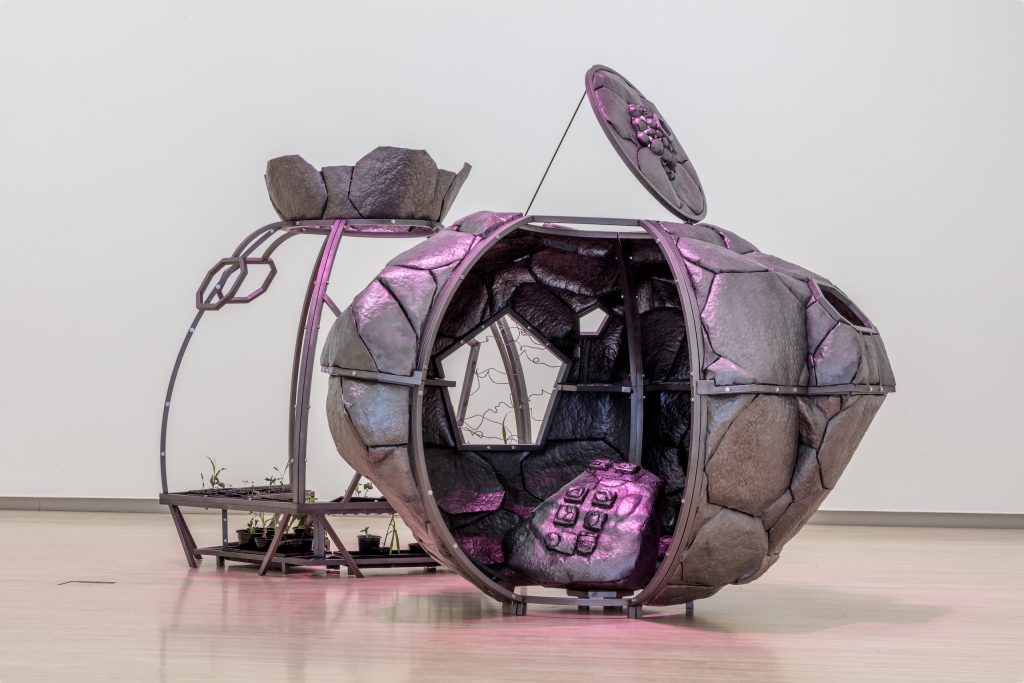
Upon entering the exhibition, one is confronted with a space-age steel structure, whose handcrafted surface evokes an epidermal layer dotted with dimples, creases, and folds. Simultaneously anthropomorphic and futuristic, Chultún El Semillero, by Beatriz Cortez, contains a seed bank and a living garden with plants native to the Americas, including quinoa, corn, and a variety of beans. Comprised of two hexagonal metal constructions connected by a narrow wire tunnel, its form alludes to chultúnes found in the lower Yucatán Peninsula in Central America, which were carved into the stone ground and used for water and food storage by the Mayans. Chultún El Semillero functions as a site of conservation and growth, where the plants within must be watered each day by museum workers in the otherwise sterile space of the museum. In this work, Cortez asks, “If we did not have access to seeds, who should get the seeds first? Who would be able to preserve them, to multiply them to make sure that we have seeds surviving in the future for our own survival?”1
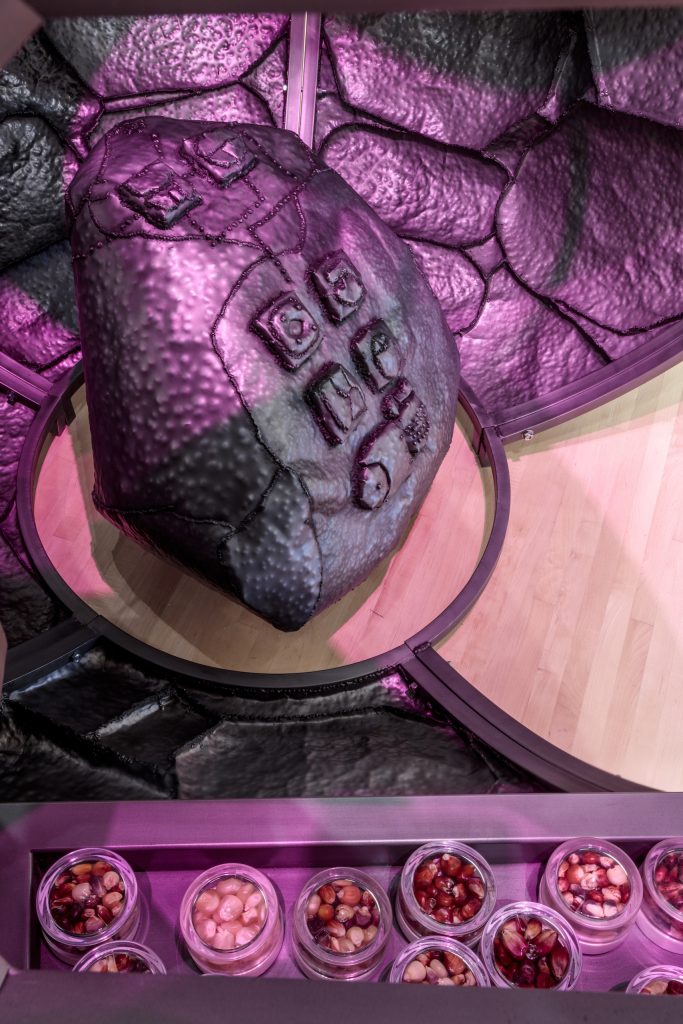
Nearby is an oversized biomorphic inflatable. Its curvilinear, elongated form grows upward from the floor, looming tall like a three-armed saguaro cactus, its transparent plastic glistens under the museum lights. It references the Wardian case, a 19th-century portable greenhouse that is the precursor to modern-day terrariums. While the Wardian case was used to create isolated, captive environments, Kapwani Kiwanga’s piece, Vivarium: Apomixis, offers an example of the creative possibilities of non-extractive methods of growth by strategically utilizing metal structures as both support for the inflatable and as an invitational trellis for plants to grow, thus functioning with, rather than taking from, its surroundings. Paintings by Emmi Whitehorse (Diné) adorn the walls in Southwestern earth tones of ochres and umbers. Atmospheric and succinct, minimal geometric abstractions form topographies layered with circular drawn seeds, plants, and animals atop saturated color fields. Above, crafted wood pods by Carolina Caycedo gently sway in crocheted nets suspended from the ceiling. The pods reference the “three sisters:” squash, maize, and beans, as an Indigenous cultivation practice of symbiotic mutualism across the Americas. Walking through this section of the exhibition is like entering a futurist dimension where familiar materials from the built and natural environment are re-presented in new ways.

Much like Butler’s protagonist, the artists in this exhibition build upon ancient forms of knowledge to lateralize human relationships with the earth and form reciprocal relationships with their given environments. Seed Blanket (Decolonize the Garden: From Seeds to Bees) by Juan William Chávez addresses localized histories of disinvestment in North St. Louis by reinvesting in the region and residents from the ground up. A floor-based assemblage composed of plants, brightly colored textiles, and a small television screen is carefully placed on a reflective mylar blanket. Ceramic vessels and dried gourds pay homage to his Peruvian heritage. At the same time, the screen plays video clips from his Northside Workshop in St. Louis, which serves as an art studio, urban teaching garden, and bee sanctuary. Through grassroots efforts, Chávez’s holistic practice nurtures a sense of community through land stewardship and food sovereignty.2
Similarly, Ellie Irons and Anne Percoco’s Next Epoch Seed Library functions as a mobile, participatory archive that reclaims environmental and social histories through the act of seed sharing. Viewers are invited to open drawers labeled with local plant species, read about their origins, and sign out seeds collected from sites across Missouri and Illinois, such as the Cahokia Mounds, the lot of the former Pruitt-Igoe housing complex, and the lawn at Bayer’s corporate headquarters (formerly Monsanto).3 By linking the seeds to a digital archive accessible via QR code, the project foregrounds ongoing changes to these landscapes while resisting the erasure of their histories. The Cahokia Mounds, once the largest Indigenous metropolis in North America, have been fragmented by centuries of development, while Pruitt-Igoe, built as an epoch of Modernist public housing in North St. Louis, came to symbolize racial inequalities shaped by urban planning before its demolition. Monsanto’s monopolized control over patented seeds and use of pesticides like Roundup exemplifies the commercialization of agriculture and its impact on the land and farmers alike. Next Epoch Seed Library documents the growth that persists in places that have experienced significant socio-ecological disruption by sharing access to localized knowledge and horticultural practices.

Jumana Manna’s installations, Family and Ghost II (Cache Series), personify ancient grain containers known as khabyas that were historically used in Palestine and throughout the Levant region.4 In the gallery, a group of two- and three-legged curvilinear ceramic vessels rest close to one another atop a grated steel plane supported by cinder blocks. Their arrangement suggests a sense of familial togetherness, though unlike traditional khabyas typically filled with nourishing sustenance, their forms are hollowed out and empty. Manna’s vessels preserve ways of knowing distinctive to a cultural landscape at risk of erasure, in Palestine and beyond. They demonstrate the vital need to care for one another and the resources that sustain life.
In the face of capitalist structures that exploit labor and land for the accumulation of profit, Seeds: Containers of a World to Come interrogates the mechanisms of power that perpetuate inequality and ecological destruction. Returning to the principles of Earthseed, this exhibition serves as a potent reminder that change is possible through an economy of care and material transformation. The seed is both a symbol and a living agent that embodies the potential to disrupt inherently violent systems of ownership, privatization, and commercialization. Together, the exhibition presents a vision of environmental and cultural resilience, presenting seeds as containers of memory, tools for resistance, and blueprints for cultivating collective futures.
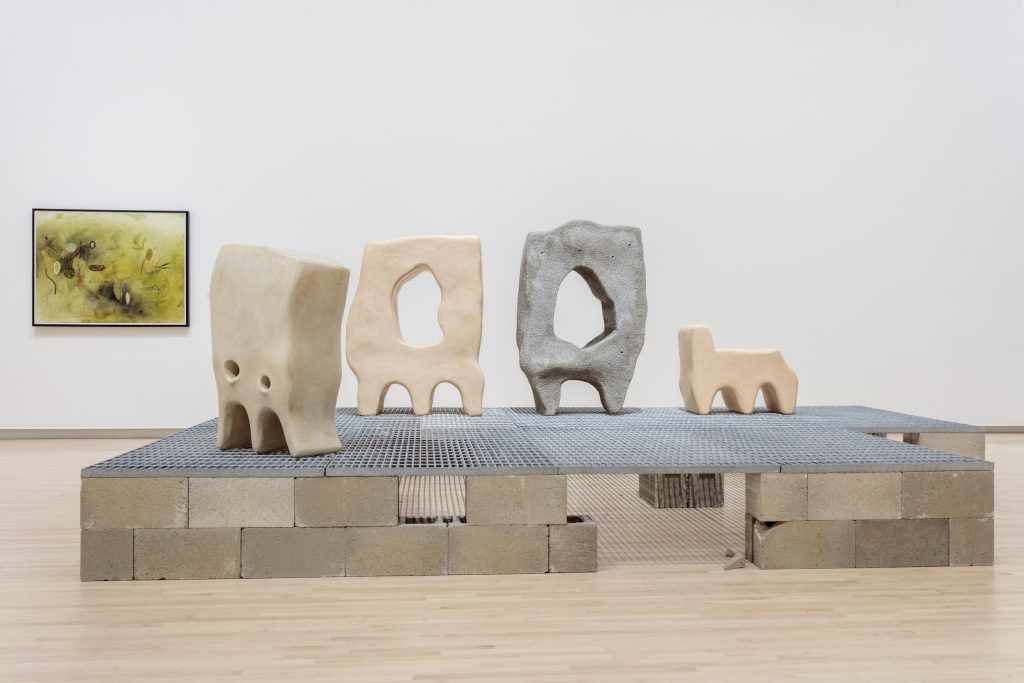
Seeds: Containers of a World to Come is on view at the Mildred Lane Kemper Art Museum in St. Louis, MO from February 21 through July 28, 2025. Curated by Meredith Malone and Svea Braeunert, artists in the exhibition include Shiraz Bayjoo, Carolina Caycedo, Juan William Chavez, Beatriz Cortez, Ellie Irons, Kapwani Kiwanga, Jumana Manna, Anne Percoco, Cicilia Vicuña, and Emmi Whitehorse.
* * *
Works Cited
- Beatriz Cortez discusses her work, Chultún El Semillero (2021), in an interview with the Kemper Art Museum. Her question about survivability not only relates to food supplies, but who controls the future of those resources and who can receive access during times of crisis. https://www.kemperartmuseum.wustl.edu/learn/learning-resources/learning-resource-video-beatriz-cortez ↩︎
- If you’d like to learn more about Juan William Chávez’s Northside Workshop, check it out here: https://northsideworkshop.org/history/ ↩︎
- For further information about Ellie Irons and Anne Percoco’s Next Epoch Seed Library, and it’s different site-specific iterations: https://nextepochseedlibrary.com/kemper/ ↩︎
- A letter to the artist on the significance of the khabya: https://www.momaps1.org/en/post/122-subject-we-come-out-to-meet-you ↩︎
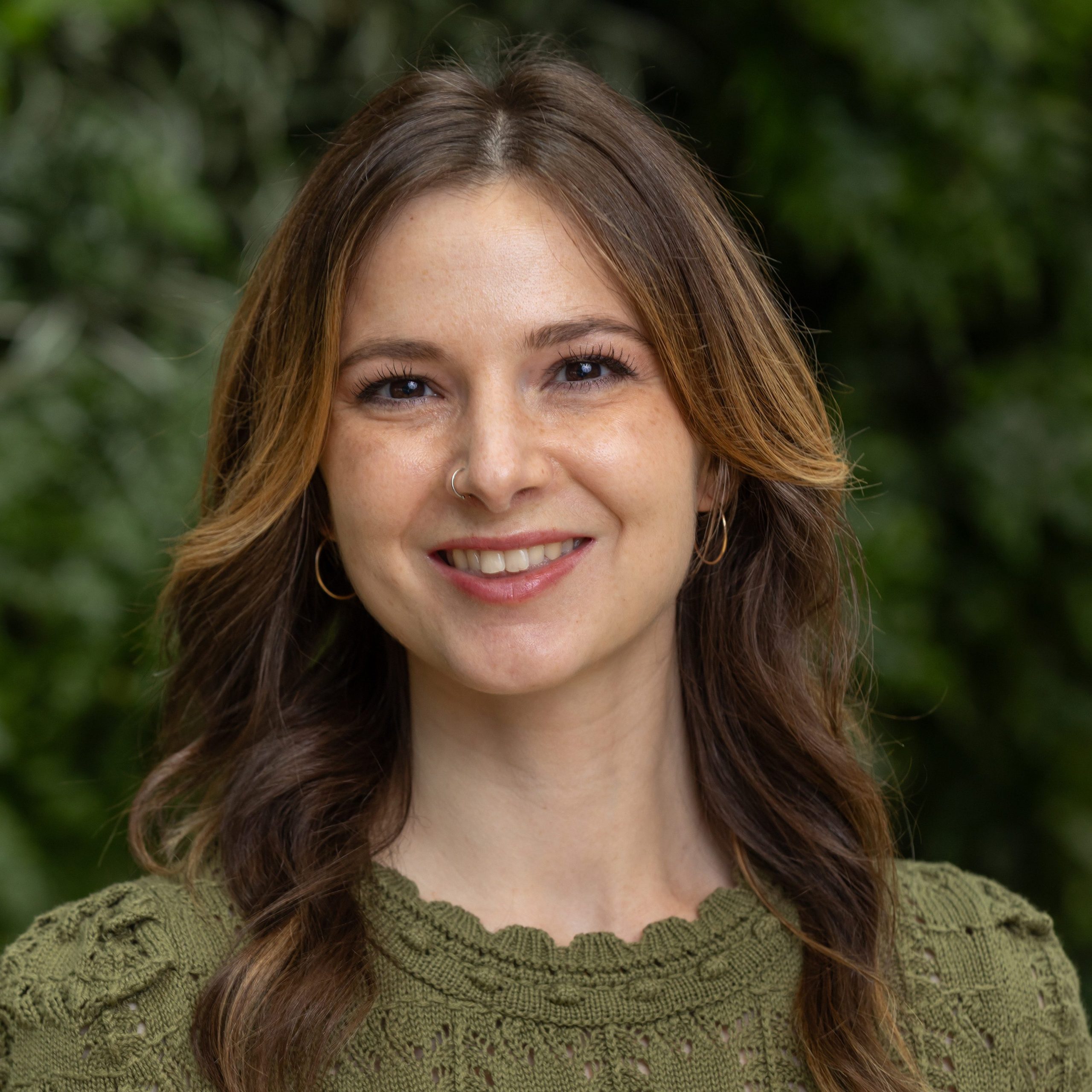
About the author: Caitlyn Lawler is a practicing artist, writer, educator, and administrator based in St. Louis, Missouri. Caitlyn received her M.A. in Art History from the University of California Riverside and her M.F.A. in Studio Art from Claremont Graduate University. Her research focuses on 20th and 21st century visual and material culture with a focus on American art. She is interested in how critical geographies affect creative place making through alternative sites and practices. She has worked in arts nonprofits in development, grants management, special projects, and higher education.
